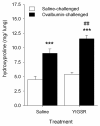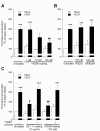The laminin β1-competing peptide YIGSR induces a hypercontractile, hypoproliferative airway smooth muscle phenotype in an animal model of allergic asthma
- PMID: 21129174
- PMCID: PMC3013082
- DOI: 10.1186/1465-9921-11-170
The laminin β1-competing peptide YIGSR induces a hypercontractile, hypoproliferative airway smooth muscle phenotype in an animal model of allergic asthma
Abstract
Background: Fibroproliferative airway remodelling, including increased airway smooth muscle (ASM) mass and contractility, contributes to airway hyperresponsiveness in asthma. In vitro studies have shown that maturation of ASM cells to a (hyper)contractile phenotype is dependent on laminin, which can be inhibited by the laminin-competing peptide Tyr-Ile-Gly-Ser-Arg (YIGSR). The role of laminins in ASM remodelling in chronic asthma in vivo, however, has not yet been established.
Methods: Using an established guinea pig model of allergic asthma, we investigated the effects of topical treatment of the airways with YIGSR on features of airway remodelling induced by repeated allergen challenge, including ASM hyperplasia and hypercontractility, inflammation and fibrosis. Human ASM cells were used to investigate the direct effects of YIGSR on ASM proliferation in vitro.
Results: Topical administration of YIGSR attenuated allergen-induced ASM hyperplasia and pulmonary expression of the proliferative marker proliferating cell nuclear antigen (PCNA). Treatment with YIGSR also increased both the expression of sm-MHC and ASM contractility in saline- and allergen-challenged animals; this suggests that treatment with the laminin-competing peptide YIGSR mimics rather than inhibits laminin function in vivo. In addition, treatment with YIGSR increased allergen-induced fibrosis and submucosal eosinophilia. Immobilized YIGSR concentration-dependently reduced PDGF-induced proliferation of cultured ASM to a similar extent as laminin-coated culture plates. Notably, the effects of both immobilized YIGSR and laminin were antagonized by soluble YIGSR.
Conclusion: These results indicate that the laminin-competing peptide YIGSR promotes a contractile, hypoproliferative ASM phenotype in vivo, an effect that appears to be linked to the microenvironment in which the cells are exposed to the peptide.
Figures





Similar articles
-
Laminin drives survival signals to promote a contractile smooth muscle phenotype and airway hyperreactivity.FASEB J. 2013 Oct;27(10):3991-4003. doi: 10.1096/fj.12-221341. Epub 2013 Jun 11. FASEB J. 2013. PMID: 23756649 Free PMC article.
-
The integrin-blocking peptide RGDS inhibits airway smooth muscle remodeling in a guinea pig model of allergic asthma.Am J Respir Crit Care Med. 2010 Mar 15;181(6):556-65. doi: 10.1164/rccm.200907-1065OC. Epub 2009 Dec 17. Am J Respir Crit Care Med. 2010. PMID: 20019343
-
Insulin-induced laminin expression promotes a hypercontractile airway smooth muscle phenotype.Am J Respir Cell Mol Biol. 2009 Oct;41(4):494-504. doi: 10.1165/rcmb.2008-0251OC. Epub 2009 Feb 12. Am J Respir Cell Mol Biol. 2009. PMID: 19213874
-
Models to understand contractile function in the airways.Pulm Pharmacol Ther. 2011 Oct;24(5):444-51. doi: 10.1016/j.pupt.2011.04.028. Epub 2011 Apr 14. Pulm Pharmacol Ther. 2011. PMID: 21511049 Review.
-
Airway structural components drive airway smooth muscle remodeling in asthma.Proc Am Thorac Soc. 2009 Dec;6(8):683-92. doi: 10.1513/pats.200907-056DP. Proc Am Thorac Soc. 2009. PMID: 20008876 Review.
Cited by
-
Airway remodeling in asthma: what really matters.Cell Tissue Res. 2017 Mar;367(3):551-569. doi: 10.1007/s00441-016-2566-8. Epub 2017 Feb 11. Cell Tissue Res. 2017. PMID: 28190087 Free PMC article. Review.
-
Role of Airway Smooth Muscle in Inflammation Related to Asthma and COPD.Adv Exp Med Biol. 2021;1303:139-172. doi: 10.1007/978-3-030-63046-1_9. Adv Exp Med Biol. 2021. PMID: 33788192
-
Integrin α7 expression is increased in asthmatic patients and its inhibition reduces Kras protein abundance in airway smooth muscle cells.Sci Rep. 2019 Jul 9;9(1):9892. doi: 10.1038/s41598-019-46260-2. Sci Rep. 2019. PMID: 31289310 Free PMC article.
-
Important lessons learned from studies on the pharmacology of glucocorticoids in human airway smooth muscle cells: Too much of a good thing may be a problem.Pharmacol Ther. 2020 Sep;213:107589. doi: 10.1016/j.pharmthera.2020.107589. Epub 2020 May 27. Pharmacol Ther. 2020. PMID: 32473159 Free PMC article. Review.
-
Laminin drives survival signals to promote a contractile smooth muscle phenotype and airway hyperreactivity.FASEB J. 2013 Oct;27(10):3991-4003. doi: 10.1096/fj.12-221341. Epub 2013 Jun 11. FASEB J. 2013. PMID: 23756649 Free PMC article.
References
-
- Bousquet J, Jeffery PK, Busse WW, Johnson M, Vignola AM. Asthma. From bronchoconstriction to airways inflammation and remodeling. Am J Respir Crit Care Med. 2000;161:1720–1745. - PubMed
Publication types
MeSH terms
Substances
LinkOut - more resources
Full Text Sources
Medical
Research Materials
Miscellaneous

